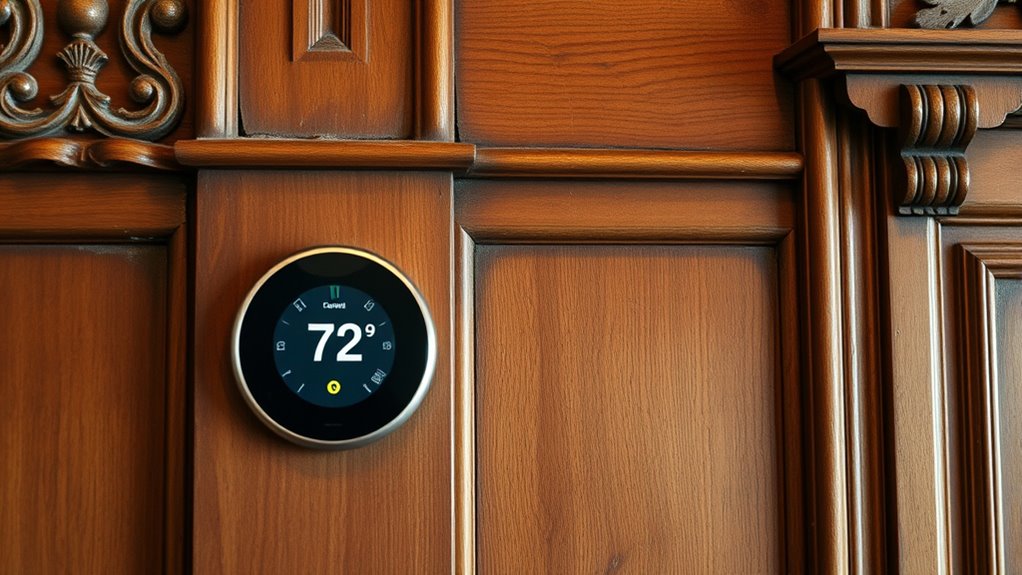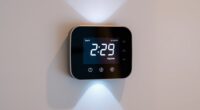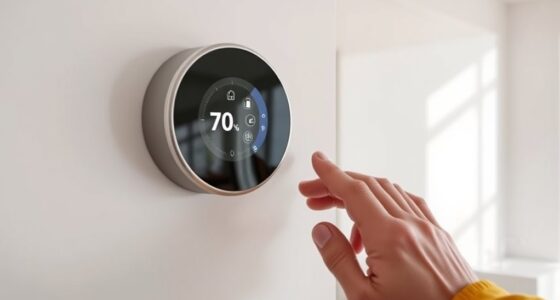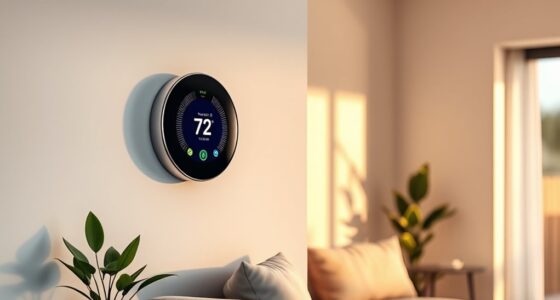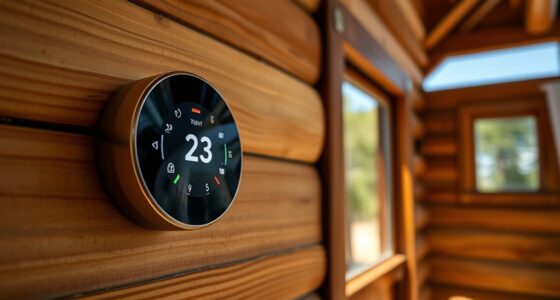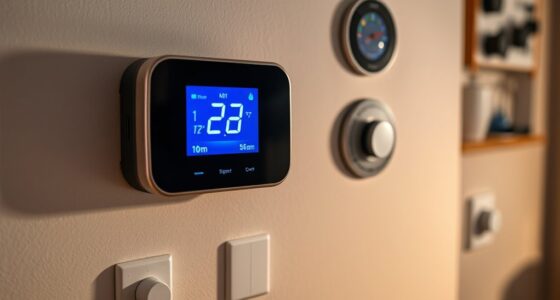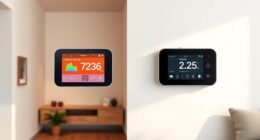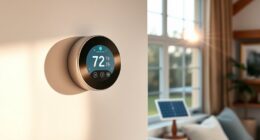When installing a smart thermostat in a historic home, you should consider the unique architecture, antique wiring, and preservation rules that may restrict modifications. It’s important to assess your electrical system, as outdated wiring might require upgrades to guarantee compatibility. Aesthetic factors also matter—choose sleek or discreet models that blend with your decor. Working with professionals can help you plan the best approach and avoid damaging your home’s charm. Discover more about making it work for your space.
Key Takeaways
- Assess existing wiring and electrical systems for compatibility or necessary upgrades before installing a smart thermostat.
- Choose discreet, aesthetically compatible models that complement the home’s historic decor and preserve its character.
- Consult professionals to evaluate installation feasibility and ensure minimal impact on structural or aesthetic features.
- Consider retrofit options or surface-mounted devices to avoid damage to walls or fixtures during installation.
- Prioritize devices with customizable settings to optimize energy efficiency without compromising the home’s vintage charm.
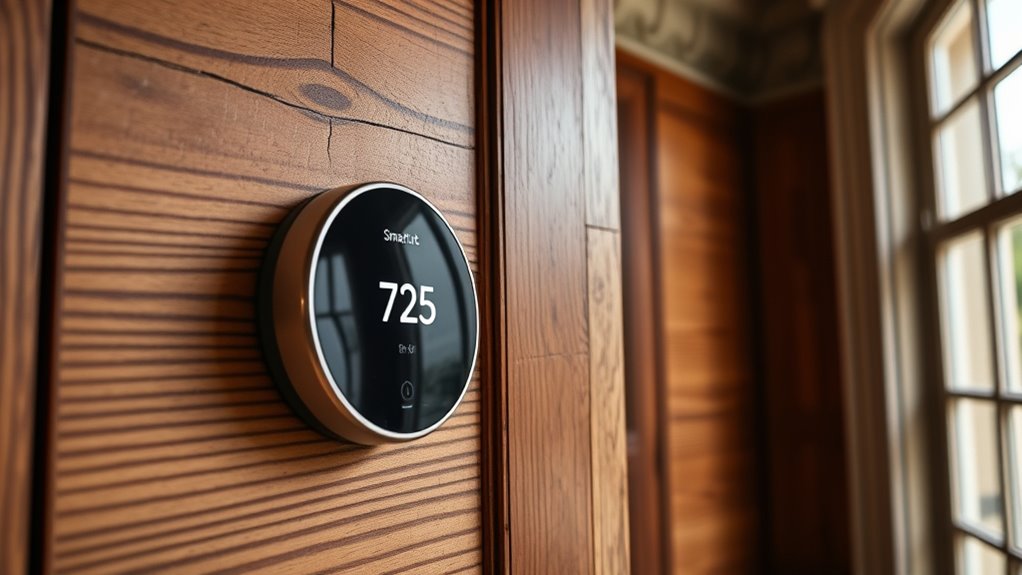
Maintaining the charm of a historic home while modernizing its climate control can be challenging, but smart thermostats offer an effective solution. These devices can help you achieve better energy efficiency and comfort without compromising the home’s traditional aesthetics. However, before you proceed, it’s vital to understand the potential installation challenges involved. Historic homes often feature unique architecture, antique wiring, and non-standard HVAC systems, which can complicate the integration of modern technology. You might encounter issues like outdated electrical systems that aren’t compatible with smart thermostats or limited space for installing new devices. Addressing these challenges requires careful planning and, sometimes, professional assessments to guarantee the thermostat can be safely and effectively installed. Additionally, understanding the unique challenges of historic properties can help you plan a smoother upgrade process. Energy efficiency is one of the key benefits of upgrading to a smart thermostat, especially in older homes where heating and cooling systems tend to be less efficient. These devices learn your schedule, adapt to your habits, and optimize temperature settings to reduce unnecessary energy consumption. This not only helps lower your utility bills but also minimizes your home’s environmental impact. With precise control over your HVAC system, you can maintain a comfortable environment while avoiding wasteful heating or cooling cycles. For historic homes, this balance is vital—preserving the house’s character while ensuring modern comfort and efficiency. When considering installation, you should also think about the aesthetic aspect. Many historic homes have strict regulations or personal preferences for maintaining their original look. Smart thermostats come in various styles, but some may not blend seamlessly with vintage decor. You might prefer models that are sleek and unobtrusive or those that can be discreetly mounted in less visible areas. To avoid damaging your walls or fixtures, you may need to explore options like surface-mounted models or retrofit kits. Consulting with HVAC professionals familiar with historic properties can help you choose a compatible device and guarantee a seamless installation process. Furthermore, it’s important to evaluate your current wiring and HVAC setup. Some older homes have non-standard wiring that might require upgrades or special adapters. Installing a smart thermostat could involve rewiring or additional electrical work, which can be a challenge but is often manageable with the right expertise. Planning ahead and working with specialists ensures that your installation won’t compromise the building’s integrity or historical value. Proper electrical assessment can prevent costly surprises during installation and ensure compatibility. In the end, embracing a smart thermostat in your historic home can be a rewarding upgrade—if you carefully navigate the installation challenges and prioritize energy efficiency without sacrificing its timeless charm.
Frequently Asked Questions
Are Smart Thermostats Compliant With Historic Preservation Regulations?
You might wonder if smart thermostats conform to preservation guidelines and obtain the necessary regulatory approvals. It’s important to check local regulations because some historic preservation rules restrict modifications to the property’s exterior or interior. Generally, if the thermostat installation doesn’t alter historic features, it can be compliant. Always consult preservation authorities or get approvals beforehand to ensure your upgrades meet preservation standards and avoid any compliance issues.
Can Smart Thermostats Be Installed Without Damaging Original Architecture?
Did you know over 60% of historic home owners want modern upgrades without damaging architecture? You can install smart thermostats without harming your home’s original features by choosing suitable installation methods and ensuring aesthetic compatibility. Use non-invasive techniques like surface mounting or wireless sensors, which preserve the structure. These methods let you enjoy smart technology while maintaining your home’s historic charm and integrity.
Do Smart Thermostats Require Wi-Fi or Internet Connection?
Smart thermostats typically require Wi Fi requirements for setup and operation, making internet dependency essential for remote control and updates. Once installed and connected to your Wi-Fi network, you can adjust settings from anywhere using your smartphone. Keep in mind, if your internet goes out, some smart thermostats may lose functionality or revert to manual control. So, a reliable internet connection is vital for seamless smart thermostat performance.
How Do Smart Thermostats Impact the Value of a Historic Home?
Imagine upgrading your historic home like adding a fine jewel—smart thermostats can enhance its charm. They often boost property valuation by showcasing modern retrofit efforts that appeal to eco-conscious buyers. A study shows smart features can increase home value by up to 5%. By integrating smart thermostats, you demonstrate ongoing maintenance and innovation, which can positively influence your home’s desirability and market worth, especially in a competitive real estate market.
Are There Energy Savings Specific to Historic Home Heating Systems?
You can see energy savings in historic home heating systems through insulation improvements and heating system upgrades. Upgrading insulation reduces heat loss, making it easier to maintain a comfortable temperature. Heating system upgrades, like modern, efficient boilers or radiators, also cut energy use. Together, these improvements lower your energy bills and boost overall efficiency, especially when combined with smart thermostats that optimize heating schedules for even greater savings.
Conclusion
Installing a smart thermostat in your historic home can boost comfort and energy efficiency without risking its charm. Did you know that smart thermostats can reduce energy bills by up to 12%? By choosing the right model and considering your home’s unique features, you’ll enjoy modern convenience while preserving its character. Embrace this technology to make your historic home more sustainable, all while saving money and enhancing your living experience.
